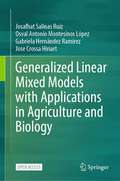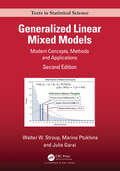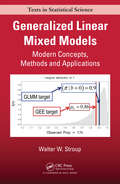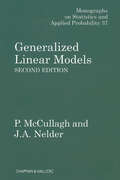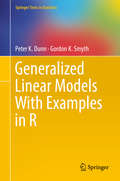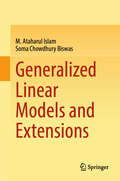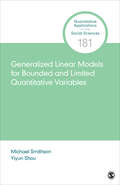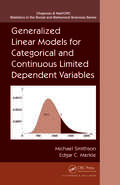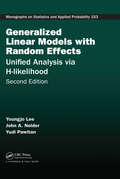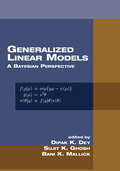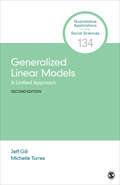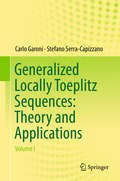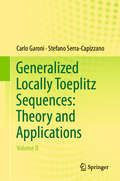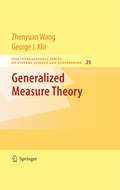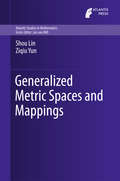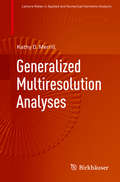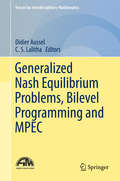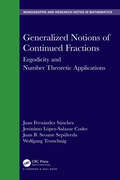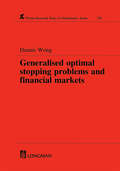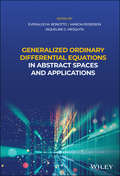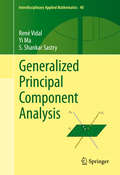- Table View
- List View
Generalized Linear Mixed Models with Applications in Agriculture and Biology
by Osval Antonio Montesinos López Josafhat Salinas Ruíz Gabriela Hernández Ramírez Jose Crossa HiriartThis open access book offers an introduction to mixed generalized linear models with applications to the biological sciences, basically approached from an applications perspective, without neglecting the rigor of the theory. For this reason, the theory that supports each of the studied methods is addressed and later - through examples - its application is illustrated. In addition, some of the assumptions and shortcomings of linear statistical models in general are also discussed. An alternative to analyse non-normal distributed response variables is the use of generalized linear models (GLM) to describe the response data with an exponential family distribution that perfectly fits the real response. Extending this idea to models with random effects allows the use of Generalized Linear Mixed Models (GLMMs). The use of these complex models was not computationally feasible until the recent past, when computational advances and improvements to statistical analysis programs allowed users to easily, quickly, and accurately apply GLMM to data sets. GLMMs have attracted considerable attention in recent years. The word "Generalized" refers to non-normal distributions for the response variable and the word "Mixed" refers to random effects, in addition to the fixed effects typical of analysis of variance (or regression). With the development of modern statistical packages such as Statistical Analysis System (SAS), R, ASReml, among others, a wide variety of statistical analyzes are available to a wider audience. However, to be able to handle and master more sophisticated models requires proper training and great responsibility on the part of the practitioner to understand how these advanced tools work. GMLM is an analysis methodology used in agriculture and biology that can accommodate complex correlation structures and types of response variables.
Generalized Linear Mixed Models: Modern Concepts, Methods and Applications (Chapman & Hall/CRC Texts in Statistical Science)
by Walter W. Stroup Marina Ptukhina Julie GaraiGeneralized Linear Mixed Models: Modern Concepts, Methods, and Applications (2nd edition) presents an updated introduction to linear modeling using the generalized linear mixed model (GLMM) as the overarching conceptual framework. For students new to statistical modeling, this book helps them see the big picture – linear modeling as broadly understood and its intimate connection with statistical design and mathematical statistics. For readers experienced in statistical practice, but new to GLMMs, the book provides a comprehensive introduction to GLMM methodology and its underlying theory.Unlike textbooks that focus on classical linear models or generalized linear models or mixed models, this book covers all of the above as members of a unified GLMM family of linear models. In addition to essential theory and methodology, this book features a rich collection of examples using SAS® software to illustrate GLMM practice. This second edition is updated to reflect lessons learned and experience gained regarding best practices and modeling choices faced by GLMM practitioners. New to this edition are two chapters focusing on Bayesian methods for GLMMs.Key Features:• Most statistical modeling books cover classical linear models or advanced generalized and mixed models; this book covers all members of the GLMM family – classical and advanced models.• Incorporates lessons learned from experience and on-going research to provide up-to-date examples of best practices.• Illustrates connections between statistical design and modeling: guidelines for translating study design into appropriate model and in-depth illustrations of how to implement these guidelines; use of GLMM methods to improve planning and design.• Discusses the difference between marginal and conditional models, differences in the inference space they are intended to address and when each type of model is appropriate.• In addition to likelihood-based frequentist estimation and inference, provides a brief introduction to Bayesian methods for GLMMs.Walt Stroup is an Emeritus Professor of Statistics. He served on the University of Nebraska statistics faculty for over 40 years, specializing in statistical modeling and statistical design. He is a Fellow of the American Statistical Association, winner of the University of Nebraska Outstanding Teaching and Innovative Curriculum Award and author or co-author of three books on mixed models and their extensions.Marina Ptukhina (Pa-too-he-nuh), PhD, is an Associate Professor of Statistics at Whitman College. She is interested in statistical modeling, design and analysis of research studies and their applications. Her research includes applications of statistics to economics, biostatistics and statistical education. Ptukhina earned a PhD in Statistics from the University of Nebraska-Lincoln, a Master of Science degree in Mathematics from Texas Tech University and a Specialist degree in Management from The National Technical University "Kharkiv Polytechnic Institute."Julie Garai, PhD, is a Data Scientist at Loop. She earned her PhD in Statistics from the University of Nebraska-Lincoln and a bachelor’s degree in Mathematics and Spanish from Doane College. Dr Garai actively collaborates with statisticians, psychologists, ecologists, forest scientists, software engineers, and business leaders in academia and industry. In her spare time, she enjoys leisurely walks with her dogs, dance parties with her children, and playing the trombone.
Generalized Linear Mixed Models: Modern Concepts, Methods and Applications (Chapman & Hall/CRC Texts in Statistical Science)
by Walter W. StroupWith numerous examples using SAS PROC GLIMMIX, this text presents an introduction to linear modeling using the generalized linear mixed model as an overarching conceptual framework. For readers new to linear models, the book helps them see the big picture. It shows how linear models fit with the rest of the core statistics curriculum and points out the major issues that statistical modelers must consider.
Generalized Linear Models (Chapman & Hall/CRC Monographs on Statistics and Applied Probability #37)
by P. McCullaghThe success of the first edition of Generalized Linear Models led to the updated Second Edition, which continues to provide a definitive unified, treatment of methods for the analysis of diverse types of data. Today, it remains popular for its clarity, richness of content and direct relevance to agricultural, biological, health, engineering, and ot
Generalized Linear Models With Examples in R (Springer Texts in Statistics)
by Peter K. Dunn Gordon K. SmythThis textbook presents an introduction to multiple linear regression, providing real-world data sets and practice problems. A practical working knowledge of applied statistical practice is developed through the use of these data sets and numerous case studies. The authors include a set of practice problems both at the end of each chapter and at the end of the book. Each example in the text is cross-referenced with the relevant data set, so that readers can load the data and follow the analysis in their own R sessions. The balance between theory and practice is evident in the list of problems, which vary in difficulty and purpose.This book is designed with teaching and learning in mind, featuring chapter introductions and summaries, exercises, short answers, and simple, clear examples. Focusing on the connections between generalized linear models (GLMs) and linear regression, the book also references advanced topics and tools that have not typically been included in introductions to GLMs to date, such as Tweedie family distributions with power variance functions, saddlepoint approximations, likelihood score tests, modified profile likelihood, and randomized quantile residuals. In addition, the authors introduce the new R code package, GLMsData, created specifically for this book. Generalized Linear Models with Examples in R balances theory with practice, making it ideal for both introductory and graduate-level students who have a basic knowledge of matrix algebra, calculus, and statistics.
Generalized Linear Models and Extensions
by M. Ataharul Islam Soma Chowdhury BiswasThis book presents a wide range of topics to address the needs of several groups of users of rapidly growing methods of generalized linear models. Since the introduction of the idea of generalized linear models (GLM) in early seventies, during the past four decades the modelling of statistical data have experienced a major transformation from linear models based on normality assumption to a more flexible unified approach of generalized linear models. The number of readers and users of generalized linear models have increased manifold. In addition, the use of generalized linear models has expanded in many new fields of applications where statistical models are being employed at an increasing rate. It is important to note here that the learners and users of GLM have a widely varied background in different disciplines. Considering these pressing needs, this book focuses on: (i) upper undergraduate and graduate level students in need of a thorough understanding about the basic concepts of generalized linear models along with appropriate applications; (ii) researchers and users in need of advanced generalized linear models for analysing bivariate or multivariate data stemming from longitudinal or repeated measures data; and (iii) new challenges to analyse big data where the traditional techniques fail to provide any reasonable modelling strategy. In other words, this book starts with a thorough background of the generalized linear models for the new learners, then provides multivariate extensions to advanced level techniques for researchers and users in various disciplines, and finally some innovative modelling strategies are introduced using generalized linear models in the emerging field of big data analytics. It provides materials for new learners, for users/researchers who are in need of more advanced techniques and also strategies for employing linear models in big data analytics. Hence, techniques of generalized linear models will be presented in the proposed book covering the needs of new learners, users of advanced techniques, researchers in need of statistical modelling of any data type and users of big data analytics wanting to increase predictive accuracy of classification and regression tree techniques.
Generalized Linear Models for Bounded and Limited Quantitative Variables (Quantitative Applications in the Social Sciences #181)
by Professor Michael Smithson Dr. Yiyun ShouThis book introduces researchers and students to the concepts and generalized linear models for analyzing quantitative random variables that have one or more bounds. Examples of bounded variables include the percentage of a population eligible to vote (bounded from 0 to 100), or reaction time in milliseconds (bounded below by 0). The human sciences deal in many variables that are bounded. Ignoring bounds can result in misestimation and improper statistical inference. Michael Smithson and Yiyun Shou's book brings together material on the analysis of limited and bounded variables that is scattered across the literature in several disciplines, and presents it in a style that is both more accessible and up-to-date. The authors provide worked examples in each chapter using real datasets from a variety of disciplines. The software used for the examples include R, SAS, and Stata. The data, software code, and detailed explanations of the example models are available on an accompanying website.
Generalized Linear Models for Bounded and Limited Quantitative Variables (Quantitative Applications in the Social Sciences #181)
by Professor Michael Smithson Dr. Yiyun ShouThis book introduces researchers and students to the concepts and generalized linear models for analyzing quantitative random variables that have one or more bounds. Examples of bounded variables include the percentage of a population eligible to vote (bounded from 0 to 100), or reaction time in milliseconds (bounded below by 0). The human sciences deal in many variables that are bounded. Ignoring bounds can result in misestimation and improper statistical inference. Michael Smithson and Yiyun Shou's book brings together material on the analysis of limited and bounded variables that is scattered across the literature in several disciplines, and presents it in a style that is both more accessible and up-to-date. The authors provide worked examples in each chapter using real datasets from a variety of disciplines. The software used for the examples include R, SAS, and Stata. The data, software code, and detailed explanations of the example models are available on an accompanying website.
Generalized Linear Models for Categorical and Continuous Limited Dependent Variables (Chapman & Hall/CRC Statistics in the Social and Behavioral Sciences)
by Michael Smithson Edgar C. MerkleGeneralized Linear Models for Categorical and Continuous Limited Dependent Variables is designed for graduate students and researchers in the behavioral, social, health, and medical sciences. It incorporates examples of truncated counts, censored continuous variables, and doubly bounded continuous variables, such as percentages.The book provides br
Generalized Linear Models for Insurance Data
by Piet De Jong Gillian Z. HellerThis is the only book actuaries need to understand generalized linear models (GLMs) for insurance applications. GLMs are used in the insurance industry to support critical decisions. Until now, no text has introduced GLMs in this context or addressed the problems specific to insurance data. Using insurance data sets, this practical, rigorous book treats GLMs, covers all standard exponential family distributions, extends the methodology to correlated data structures, and discusses recent developments which go beyond the GLM. The issues in the book are specific to insurance data, such as model selection in the presence of large data sets and the handling of varying exposure times. Exercises and data-based practicals help readers to consolidate their skills, with solutions and data sets given on the companion website. Although the book is package-independent, SAS code and output examples feature in an appendix and on the website. In addition, R code and output for all the examples are provided on the website.
Generalized Linear Models with Random Effects: Unified Analysis via H-likelihood, Second Edition (Chapman & Hall/CRC Monographs on Statistics and Applied Probability)
by Youngjo Lee John A. Nelder Yudi PawitanThis is the second edition of a monograph on generalized linear models with random effects that extends the classic work of McCullagh and Nelder. It has been thoroughly updated, with around 80 pages added, including new material on the extended likelihood approach that strengthens the theoretical basis of the methodology, new developments in variable selection and multiple testing, and new examples and applications. It includes an R package for all the methods and examples that supplement the book.
Generalized Linear Models: A Bayesian Perspective (Chapman & Hall/CRC Biostatistics Series)
by Sujit K. Ghosh Bani K. Mallick Dipak K. DeyThis volume describes how to conceptualize, perform, and critique traditional generalized linear models (GLMs) from a Bayesian perspective and how to use modern computational methods to summarize inferences using simulation. Introducing dynamic modeling for GLMs and containing over 1000 references and equations, Generalized Linear Models considers
Generalized Linear Models: A Unified Approach (Quantitative Applications in the Social Sciences #134)
by Jefferson M. Gill Silvia Michelle Torres PachecoGeneralized Linear Models: A Unified Approach provides an introduction to and overview of GLMs, with each chapter carefully laying the groundwork for the next. The Second Edition provides examples using real data from multiple fields in the social sciences such as psychology, education, economics, and political science, including data on voting intentions in the 2016 U.S. Republican presidential primaries. The Second Edition also strengthens material on the exponential family form, including a new discussion on the multinomial distribution; adds more information on how to interpret results and make inferences in the chapter on estimation procedures; and has a new section on extensions to generalized linear models. Software scripts, supporting documentation, data for the examples, and some extended mathematical derivations are available on the authors’ websites as well as through the \texttt{R} package \texttt{GLMpack}. Supporting material (data and code) to replicate the examples in the book can be found in the ′GLMpack′ package on CRAN or on the website&
Generalized Linear Models: A Unified Approach (Quantitative Applications in the Social Sciences #134)
by Jefferson M. Gill Silvia Michelle Torres PachecoGeneralized Linear Models: A Unified Approach provides an introduction to and overview of GLMs, with each chapter carefully laying the groundwork for the next. The Second Edition provides examples using real data from multiple fields in the social sciences such as psychology, education, economics, and political science, including data on voting intentions in the 2016 U.S. Republican presidential primaries. The Second Edition also strengthens material on the exponential family form, including a new discussion on the multinomial distribution; adds more information on how to interpret results and make inferences in the chapter on estimation procedures; and has a new section on extensions to generalized linear models. Software scripts, supporting documentation, data for the examples, and some extended mathematical derivations are available on the authors’ websites as well as through the \texttt{R} package \texttt{GLMpack}. Supporting material (data and code) to replicate the examples in the book can be found in the ′GLMpack′ package on CRAN or on the website&
Generalized Locally Toeplitz Sequences: Theory and Applications
by Carlo Garoni Stefano Serra-CapizzanoBased on their research experience, the authors propose a reference textbook in two volumes on the theory of generalized locally Toeplitz sequences and their applications. This first volume focuses on the univariate version of the theory and the related applications in the unidimensional setting, while the second volume, which addresses the multivariate case, is mainly devoted to concrete PDE applications. This book systematically develops the theory of generalized locally Toeplitz (GLT) sequences and presents some of its main applications, with a particular focus on the numerical discretization of differential equations (DEs). It is the first book to address the relatively new field of GLT sequences, which occur in numerous scientific applications and are especially dominant in the context of DE discretizations. Written for applied mathematicians, engineers, physicists, and scientists who (perhaps unknowingly) encounter GLT sequences in their research, it is also of interest to those working in the fields of Fourier and functional analysis, spectral analysis of DE discretization matrices, matrix analysis, measure and operator theory, numerical analysis and linear algebra. Further, it can be used as a textbook for a graduate or advanced undergraduate course in numerical analysis.
Generalized Locally Toeplitz Sequences: Volume I
by Carlo Garoni Stefano Serra-CapizzanoBased on the authors’ research experience, this two-volume reference textbook focuses on the theory of generalized locally Toeplitz sequences and its applications. The first volume discusses the univariate version of the theory and the related applications in the unidimensional setting, while this second volume, which addresses the multivariate case, is mainly devoted to concrete PDE applications. This book systematically develops the multivariate version of the theory of generalized locally Toeplitz (GLT) sequences and presents some of its main applications to the numerical discretization of partial differential equations (PDEs). Written for applied mathematicians, engineers, physicists, and scientists who (perhaps unknowingly) encounter GLT sequences in their research, it is also of interest to those working in the fields of Fourier and functional analysis, spectral analysis of PDE discretization matrices, matrix analysis, numerical analysis, linear and multilinear algebra. Further, it can be used as a textbook for graduate or advanced undergraduate courses in numerical analysis.
Generalized Measure Theory
by Zhenyuan Wang George J. KlirGeneralized Measure Theory examines the relatively new mathematical area of generalized measure theory. The exposition unfolds systematically, beginning with preliminaries and new concepts, followed by a detailed treatment of important new results regarding various types of nonadditive measures and the associated integration theory. The latter involves several types of integrals: Sugeno integrals, Choquet integrals, pan-integrals, and lower and upper integrals. All of the topics are motivated by numerous examples, culminating in a final chapter on applications of generalized measure theory. Some key features of the book include: many exercises at the end of each chapter along with relevant historical and bibliographical notes, an extensive bibliography, and name and subject indices. The work is suitable for a classroom setting at the graduate level in courses or seminars in applied mathematics, computer science, engineering, and some areas of science. A sound background in mathematical analysis is required. Since the book contains many original results by the authors, it will also appeal to researchers working in the emerging area of generalized measure theory.
Generalized Metric Spaces and Mappings
by Shou Lin Ziqiu YunThe idea of mutual classification of spaces and mappings is one of the main research directions of point set topology. In a systematical way, this book discusses the basic theory of generalized metric spaces by using the mapping method, and summarizes the most important research achievements, particularly those from Chinese scholars, in the theory of spaces and mappings since the 1960s. This book has three chapters, two appendices and a list of more than 400 references. The chapters are "The origin of generalized metric spaces", "Mappings on metric spaces" and "Classes of generalized metric spaces". Graduates or senior undergraduates in mathematics major can use this book as their text to study the theory of generalized metric spaces. Researchers in this field can also use this book as a valuable reference.
Generalized Multiresolution Analyses (Applied and Numerical Harmonic Analysis)
by Kathy D. MerrillThis monograph presents the first unified exposition of generalized multiresolution analyses. Expanding on the author’s pioneering work in the field, these lecture notes provide the tools and framework for using GMRAs to extend results from classical wavelet analysis to a more general setting. Beginning with the basic properties of GMRAs, the book goes on to explore the multiplicity and dimension functions of GMRA, wavelet sets, and generalized filters. The author’s constructions of wavelet sets feature prominently, with figures to illustrate their remarkably simple geometric form. The last three chapters exhibit extensions of wavelet theory and GMRAs to other settings. These include fractal spaces, wavelets with composite dilations, and abstract constructions of GMRAs beyond the usual setting of L2(ℝn).This account of recent developments in wavelet theory will appeal to researchers and graduate students with an interest in multiscale analysis from a pure or applied perspective. Familiarity with harmonic analysis and operator theory will be helpful to the reader, though the only prerequisite is graduate level experience with real and functional analysis.
Generalized Nash Equilibrium Problems, Bilevel Programming and MPEC (Forum for Interdisciplinary Mathematics)
by Didier Aussel C. S. LalithaThe book discusses three classes of problems: the generalized Nash equilibrium problems, the bilevel problems and the mathematical programming with equilibrium constraints (MPEC). These problems interact through their mathematical analysis as well as their applications. The primary aim of the book is to present the modern tool of variational analysis and optimization, which are used to analyze these three classes of problems. All contributing authors are respected academicians, scientists and researchers from around the globe. These contributions are based on the lectures delivered by experts at CIMPA School, held at the University of Delhi, India, from 25 November–6 December 2013, and peer-reviewed by international experts. The book contains five chapters. Chapter 1 deals with nonsmooth, nonconvex bilevel optimization problems whose feasible set is described by using the graph of the solution set mapping of a parametric optimization problem. Chapter 2 describes a constraint qualification to MPECs considered as an application of calmness concept of multifunctions and is used to derive M-stationarity conditions for MPEC. Chapter 3 discusses the first- and second-order optimality conditions derived for a special case of a bilevel optimization problem in which the constraint set of the lower level problem is described as a general compact convex set. Chapter 4 concentrates the results of the modelization and analysis of deregulated electricity markets with a focus on auctions and mechanism design. Chapter 5 focuses on optimization approaches called reflection methods for protein conformation determination within the framework of matrix completion. The last chapter (Chap. 6) deals with the single-valuedness of quasimonotone maps by using the concept of single-directionality with a special focus on the case of the normal operator of lower semi-continuous quasiconvex functions.
Generalized Notions of Continued Fractions: Ergodicity and Number Theoretic Applications (Chapman & Hall/CRC Monographs and Research Notes in Mathematics)
by Wolfgang Trutschnig Juan Fernández Sánchez Jerónimo López-Salazar Codes Juan B. Seoane SepúlvedaAncient times witnessed the origins of the theory of continued fractions. Throughout time, mathematical geniuses such as Euclid, Aryabhata, Fibonacci, Bombelli, Wallis, Huygens, or Euler have made significant contributions to the development of this famous theory, and it continues to evolve today, especially as a means of linking different areas of mathematics.This book, whose primary audience is graduate students and senior researchers, is motivated by the fascinating interrelations between ergodic theory and number theory (as established since the 1950s). It examines several generalizations and extensions of classical continued fractions, including generalized Lehner, simple, and Hirzebruch-Jung continued fractions. After deriving invariant ergodic measures for each of the underlying transformations on [0,1] it is shown that any of the famous formulas, going back to Khintchine and Levy, carry over to more general settings. Complementing these results, the entropy of the transformations is calculated and the natural extensions of the dynamical systems to [0,1]2 are analyzed. Features Suitable for graduate students and senior researchers Written by international senior experts in number theory Contains the basic background, including some elementary results, that the reader may need to know before hand, making it a self-contained volume
Generalized Optimal Stopping Problems and Financial Markets (Chapman And Hall/crc Research Notes In Mathematics Ser. #358)
by Dennis WongProvides mathematicians and applied researchers with a well-developed framework in which option pricing can be formulated, and a natural transition from the theory of optimal stopping problems to the valuation of different kinds of options. With the introduction of generalized optimal stopping theory, a unifying approach to option pricing is presented.
Generalized Ordinary Differential Equations in Abstract Spaces and Applications
by Márcia Federson Everaldo M. Bonotto Jaqueline G. MesquitaGENERALIZED ORDINARY DIFFERENTIAL EQUATIONS IN ABSTRACT SPACES AND APPLICATIONS Explore a unified view of differential equations through the use of the generalized ODE from leading academics in mathematics Generalized Ordinary Differential Equations in Abstract Spaces and Applications delivers a comprehensive treatment of new results of the theory of Generalized ODEs in abstract spaces. The book covers applications to other types of differential equations, including Measure Functional Differential Equations (measure FDEs). It presents a uniform collection of qualitative results of Generalized ODEs and offers readers an introduction to several theories, including ordinary differential equations, impulsive differential equations, functional differential equations, dynamical equations on time scales, and more. Throughout the book, the focus is on qualitative theory and on corresponding results for other types of differential equations, as well as the connection between Generalized Ordinary Differential Equations and impulsive differential equations, functional differential equations, measure differential equations and dynamic equations on time scales. The book’s descriptions will be of use in many mathematical contexts, as well as in the social and natural sciences. Readers will also benefit from the inclusion of: A thorough introduction to regulated functions, including their basic properties, equiregulated sets, uniform convergence, and relatively compact sets An exploration of the Kurzweil integral, including its definitions and basic properties A discussion of measure functional differential equations, including impulsive measure FDEs The interrelationship between generalized ODEs and measure FDEs A treatment of the basic properties of generalized ODEs, including the existence and uniqueness of solutions, and prolongation and maximal solutions Perfect for researchers and graduate students in Differential Equations and Dynamical Systems, Generalized Ordinary Differential Equations in Abstract Spaces and Applications will also earn a place in the libraries of advanced undergraduate students taking courses in the subject and hoping to move onto graduate studies.
Generalized Principal Component Analysis
by René Vidal Yi Ma S. S. SastryThis book provides a comprehensive introduction to the latest advances in the mathematical theory and computational tools for modeling high-dimensional data drawn from one or multiple low-dimensional subspaces (or manifolds) and potentially corrupted by noise, gross errors, or outliers. This challenging task requires the development of new algebraic, geometric, statistical, and computational methods for efficient and robust estimation and segmentation of one or multiple subspaces. The book also presents interesting real-world applications of these new methods in image processing, image and video segmentation, face recognition and clustering, and hybrid system identification etc. This book is intended to serve as a textbook for graduate students and beginning researchers in data science, machine learning, computer vision, image and signal processing, and systems theory. It contains ample illustrations, examples, and exercises and is made largely self-contained with three Appendices which survey basic concepts and principles from statistics, optimization, and algebraic-geometry used in this book. René Vidal is a Professor of Biomedical Engineering and Director of the Vision Dynamics and Learning Lab at The Johns Hopkins University. Yi Ma is Executive Dean and Professor at the School of Information Science and Technology at ShanghaiTech University. S. Shankar Sastry is Dean of the College of Engineering, Professor of Electrical Engineering and Computer Science and Professor of Bioengineering at the University of California, Berkeley.
Generalized Rough Sets
by Anjan MukherjeeThe book introduces the concept of "generalized interval valued intuitionistic fuzzy soft sets". It presents the basic properties of these sets and also, investigates an application of generalized interval valued intuitionistic fuzzy soft sets in decision making with respect to interval of degree of preference. The concept of "interval valued intuitionistic fuzzy soft rough sets" is discussed and interval valued intuitionistic fuzzy soft rough set based multi criteria group decision making scheme is presented, which refines the primary evaluation of the whole expert group and enables us to select the optimal object in a most reliable manner. The book also details concept of interval valued intuitionistic fuzzy sets of type 2. It presents the basic properties of these sets. The book also introduces the concept of "interval valued intuitionistic fuzzy soft topological space (IVIFS topological space)" together with intuitionistic fuzzy soft open sets (IVIFS open sets) and intuitionistic fuzzy soft closed sets (IVIFS closed sets).
